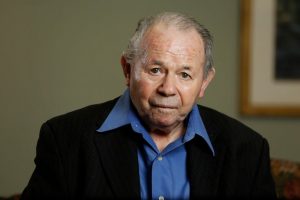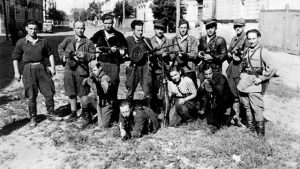Benjamin Levin — Association of Jews of Vilna and vicinity in Israel
Benjamin Levin
‘Avenger’ Benjamin Levin, ‘Forrest Gump of Jewish history,’ succumbs to COVID-19.
From killing Nazis in Lithuanian forests to jumping from flaming Altalena off Tel Aviv, young hero of Jewish Vilna participated in more than his share of Jewry’s turning points.
When Benjamin Levin told his life-story to Steven Spielberg, the acclaimed director called Levin “the Forrest Gump of Jewish history.”
As the youngest and last surviving member of the celebrated “Avengers” partisan group, Levin later swam off the destroyed Altalena and smuggled himself into the new Jewish state. Last week, at age 93, Levin succumbed to a brief battle with COVID-19 outside New York City.
The formative experiences of Levin’s life took place during the Holocaust, when he joined the “Avengers” partisan group. In the forests of Lithuania, the adolescent fighter killed Nazis, blew up their trains and bridges, and helped sustain other Jews trapped inside ghettos.
Calling his late father “extraordinarily unassuming,” son Chaim Levin spoke with The Times of Israel on Thursday. According to Levin, the key moments of his father’s life revolved around making difficult choices.
“Ordinary people are put into extraordinary circumstances,” said Levin. “What they do after is the measure of humanity.”
After watching the Nazis decimate the Jewish community of Vilna, Levin joined the “Avengers,” a small partisan band led by firebrand Abba Kovner. Levin was 14 and had a pronounced “wild streak,” having been in a youth gang and smoked cigarettes since age 8.
Important for the partisan group, Levin brought the asset of short stature and non-assuming looks. These traits served him well as a scout and saboteur.
During the German occupation of Lithuania, Levin’s group destroyed miles of railroads, blew up bridges, and killed an estimated 212 Nazis. Prisoners were never taken, including when the Jewish partisans helped liberate Vilnius in 1944. Marching through town with the Red Army, the “Avengers” identified collaborators for execution.
Although Levin’s parents survived the war, they were killed by neighbors in Vilnius when they came to reclaim their home. Chaim Levin is named after his grandfather, whom he never met.
After the murder of his parents, Levin and his sister to moved to pre-state Israel, where he joined the extremist Irgun.
Levin began his career in the right-wing paramilitary group by transporting Jewish survivors from Europe to pre-state Israel. Traveling through Turkey and Syria, Levin’s partisan skills served him until the Soviet army arrested him for these illegal activities.
After spending one year in a Siberian gulag, Levin hitchhiked his way to Italy and rejoined the Irgun. The organization helped him complete a degree in mechanical engineering, after which they assigned him to the engine room of a ship that sailed around Europe and North Africa in search of funds, ammunition, and fighters for the nascent Jewish state.
After a year of sailing, the ship was renamed Altalena. In addition to heavy ammunition donated by France, on board were hundreds of Holocaust survivors and American volunteers.
In June 1948, a few weeks after David Ben-Gurion declared Jewish statehood, the Altalena attempted to dock in Tel Aviv. Once docked, Irgun members could rearm their comrades engaged in battles for Israel’s survival.
Ben-Gurion, of course, was not willing to tolerate a second armed force under the control of his political enemies. The IDF had just been established, and one of its first actions was to attack the Altalena on Ben-Gurion’s orders.
Under machine-gun fire and shelling, Levin was among the last people to jump from the smoldering ship, along with its captain. Thirteen Irgun members and nine Holocaust survivors were killed in the IDF action to ensure the state’s monopoly on force.
Along with several other Irgun fighters, Levin managed to cross the beach and sneak into the country. Three years later, he met his wife Sara, a Hungarian Jew. In another twist of fate, Sara happened to have been serving with the Haganah during the Altalena confrontation, supporting soldiers as they fired on the ship her future husband was on.
Although political opposites within Zionism, the couple had two children and moved to the US in 1967. After working as a mechanic for the NYC transportation authority, Levin fulfilled a dream by owning his own gas station.
A few years after the release of “Schindler’s List” in 1993, director Spielberg interviewed Holocaust survivors around the country. For several days, Spielberg sat with Levin and his family. During this time, Chaim Levin told The Times of Israel, his father drew a detailed map of pre-war Vilna, having been intimately familiar with every alleyway.
“After hearing about his life, Spielberg called my dad ‘The Forrest Gump of Jewish history,'” said Levin. In the 1994 film “Forrest Gump” starring Tom Hanks, the protagonist finds himself at the center of many turning points in history. Forrest had Vietnam, JFK, and running across America. Levin had Lithuanian forests, Abba Kovner, and swimming ashore from the Altalena.
For many years, Levin was a fixture at New York City high schools, where he spoke about the Holocaust and importance of the choices people make. For the past few years, said Chaim Levin, the survivor needed his son to be his voice in these encounters. However, he still relished the hugs and handshakes bestowed on him by thousands of students through the years.
Despite the horrific circumstances of his youth, Levin was known to have “an enormous amount of energy and joy and love,” said his son. “He was by far the most popular person in the nursing home.”
For Chaim Levin, there was an element of symbolism in COVID-19 having ended his father’s life. Pointing out the medical professionals and front-line staff dealing with the pandemic, Levin noted that they, like his father, were making life and death choices.
“We see ordinary people risking their own lives in extraordinary circumstances to save others,” said Levin.
In another symbolic alignment, Levin passed away on the early morning of the fifth day of Passover. During the war, Levin had assumed so many identities that he eventually forgot his birthday. With the Passover holiday’s themes of liberation and renewal fitting Levin’s life so well, the family decided to make Passover his birthday.
When asked about the lessons taught by his father, Levin pointed to the initial weeks of the German occupation of Vilna.
Having witnessed the mass murder of his city’s Jewish community, Benjamin Levin assumed his time would come within a year or two. His street-smarts and non-threatening appearance would only serve him for so long, reasoned the the 14-year old.
“My father did not expect that he would make it to 16,” said Levin. “It was never a given.”
Contact us:
Contact
Directions: Beit Vilna, 30 Sderot Yehudit, Tel-Aviv.
Mailing address: P.O.Box 1005, Ramat Hasharon, 4711001. [email protected].
Tel. 03-5616706
[email protected]
Accessibility Statement



